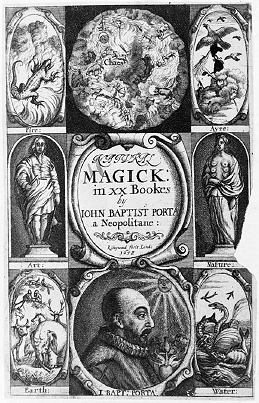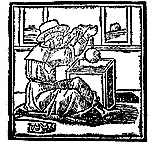
Giambattista della Porta

Frontispiece of 1658 English translation of Natural Magick
|
NATURAL
MAGICK IN
XX BOOKS
The Eighteenth Book
“Of Static Experiments”
(“Treating of things heavy and light.”)
CHAPTER
VIII
“How the levity in the water and the air, is different,
and what cunning may be wrought thereby.”
Now I will speak of heavy and light, otherwise than I spoke before. Namely, how it is in the air, and how in the water, and what speculation or profit may rise from thence. And first how we may know whether a metal be pure, or mingled with other metals, as Gold and Silver, as in Gilded cups, or else in monies. Where Silver or Gold is mingled with Brass, and what is their several weights. Which speculation is useful not only for Bankers, but also for Smiths, when they desire to try metals in Fixing of Silver, or other operations, which I will attempt to declare plainly. But first I will see whether the Ancients speak anything hereof. Vitruvius says Archimedes did write of this. For when Hiero purposed to off a golden Crown to the Gods in the temple, he put it to the Goldsmith by weight. He made the work curiously, and maintained it for good to the King, and by weight it seemed to be just. But afterwards it was said, that he had stolen part of the Gold, and made up the Crown with Silver to the full weight. Hiero enraged at this, had Archimedes to consider of it. He then by chance coming into a bath, when he had descended into it, he observed that as much of his body as went into the bath, so much water ran over the bath. When he considered the reason of it, he leaped forth for joy, running home and crying Eureka, Eureka, that is, I have found it, I have found it. Then they say he made to lumps of equal weight with the Crown, one of Gold, the other of Silver. Then he filled a large vessel to the very brims with water, and he put in the lump of Silver. The bigness of that thrust into the water, made the water run over. Wherefore taking out the lump, what flowed over he put in again, having measured a fixed part. And he found what certain quantity of water answered to the quantity of the Silver. Then he put in the lump of Gold into the full vessel, and taking that forth, by the same reason he found that not so much water ran forth, but so much less of the body of the Gold was less than the same weight in Silver. Then he filled the vessel with water, and put in the Crown, and he found that more water ran forth by reason of the Crown, than for the mass of Gold of the same weight, and from thence because more water run over by reason of the Crown, than for the Gold lump, he reasoned there must be a mixture in the Crown. This was the Greek's invention, that is worthy of praise. But the operation is difficult. For in things of small quantity the theft cannot be discerned, nor can this reason appear so clear to the eye, where the absolute fashion of the vessel was wanting. Now a way is invented how for all money, be it never so small, we can tell presently, and we want not many instruments, that we may cry, we have oversounded Supereureka, Supereureka, we have gone beyond Archimedes his Eureka. The way is,
“To know any part of Silver mingled with Gold.”
 Take a perfect Balance, and put in one Scale of any metal. In the other as much of the same metal, but the purest of its kind. And when the Scales hang even in the air, put them into a vessel full of water, and let them down under water about half a foot. Then will it be a strange wonder, for the Balances that hang equal in the air, will change their nature in the water, and will be unequal. For the impure metal will be uppermost, and the pure will sink to the bottom. The reason is, because pure Gold compared, with that kind, is heavier than all impure Gold, because pure Gold takes less place. Wherefore it will weigh heavier by the former reason. If then we would know how much Silver is in the Gold, put as much pure Gold in the other Scale, as will make the Balances equal under the waters. When they are equal take them up, and the weight you added under water, will be the weight of the mixture. If you would know how much Gold is upon a vessel Gilded. Put the cup in one Scale, and as much pure Silver in the other, that the Scales may hang equal in the air. Then put them under the water and the vessel will sink down. Put into the other Scale as much pure Gold, as will make them equal under water. Draw them forth, and that is the weight of the Gilt of the plate. You shall do the same for Silver, Brass, Iron, white or black Lead. But would you know whether in money, Brass be mingled with Silver, or coin be adulterated with Copper. Put the money into one Scale, and as much of the finest Silver into the other. Balance them equal. Then up them under the water. The money will go down. Add as much Brass as will make the Scales equal, then take them forth. And it will be the weight of the mixture. Now will I set the weights of metals, how much they weigh more in the waters, then in the air, whereby without any other experiments we may know mixtures. An Iron ball that weighs nineteen ounces in the air, will weigh fifteen in the water. Whence it is that proportion of Iron in the Air to the same in the waters, is fifteen to nineteen. A Lead bullet of the same magnitude, weights 31 ounces in the air, in the water but 27. A Marble bullet little less for bulk, weighs 7 in the air, and 5 in the water. Copper weighs 16 in the air, and 12 in the waters. Silver weighs in the air 127, in the waters 113. Brass in the air weighs 65 Carats, and one Grain, in the waters 50 Carats and two Grains. Crown Gold in the air weighs 66 Grains, in the waters 62. Gold called Zechini in the air weights 17 carats, under water 16 Carats. Turkish Ducat Gold weighs in the air 34, under water 32. Common French Crown Gold weighs in the air 67, under waters 60. Common Crown Gold of Hungary that is old,in the air weighs 17, in the water 16. Crown Gold of Tartary weighs 16 in the air, and 14 under water.
Take a perfect Balance, and put in one Scale of any metal. In the other as much of the same metal, but the purest of its kind. And when the Scales hang even in the air, put them into a vessel full of water, and let them down under water about half a foot. Then will it be a strange wonder, for the Balances that hang equal in the air, will change their nature in the water, and will be unequal. For the impure metal will be uppermost, and the pure will sink to the bottom. The reason is, because pure Gold compared, with that kind, is heavier than all impure Gold, because pure Gold takes less place. Wherefore it will weigh heavier by the former reason. If then we would know how much Silver is in the Gold, put as much pure Gold in the other Scale, as will make the Balances equal under the waters. When they are equal take them up, and the weight you added under water, will be the weight of the mixture. If you would know how much Gold is upon a vessel Gilded. Put the cup in one Scale, and as much pure Silver in the other, that the Scales may hang equal in the air. Then put them under the water and the vessel will sink down. Put into the other Scale as much pure Gold, as will make them equal under water. Draw them forth, and that is the weight of the Gilt of the plate. You shall do the same for Silver, Brass, Iron, white or black Lead. But would you know whether in money, Brass be mingled with Silver, or coin be adulterated with Copper. Put the money into one Scale, and as much of the finest Silver into the other. Balance them equal. Then up them under the water. The money will go down. Add as much Brass as will make the Scales equal, then take them forth. And it will be the weight of the mixture. Now will I set the weights of metals, how much they weigh more in the waters, then in the air, whereby without any other experiments we may know mixtures. An Iron ball that weighs nineteen ounces in the air, will weigh fifteen in the water. Whence it is that proportion of Iron in the Air to the same in the waters, is fifteen to nineteen. A Lead bullet of the same magnitude, weights 31 ounces in the air, in the water but 27. A Marble bullet little less for bulk, weighs 7 in the air, and 5 in the water. Copper weighs 16 in the air, and 12 in the waters. Silver weighs in the air 127, in the waters 113. Brass in the air weighs 65 Carats, and one Grain, in the waters 50 Carats and two Grains. Crown Gold in the air weighs 66 Grains, in the waters 62. Gold called Zechini in the air weights 17 carats, under water 16 Carats. Turkish Ducat Gold weighs in the air 34, under water 32. Common French Crown Gold weighs in the air 67, under waters 60. Common Crown Gold of Hungary that is old,in the air weighs 17, in the water 16. Crown Gold of Tartary weighs 16 in the air, and 14 under water.
|
![]() Natural Magick
Natural Magick![]() Medieval Treatise
Medieval Treatise


